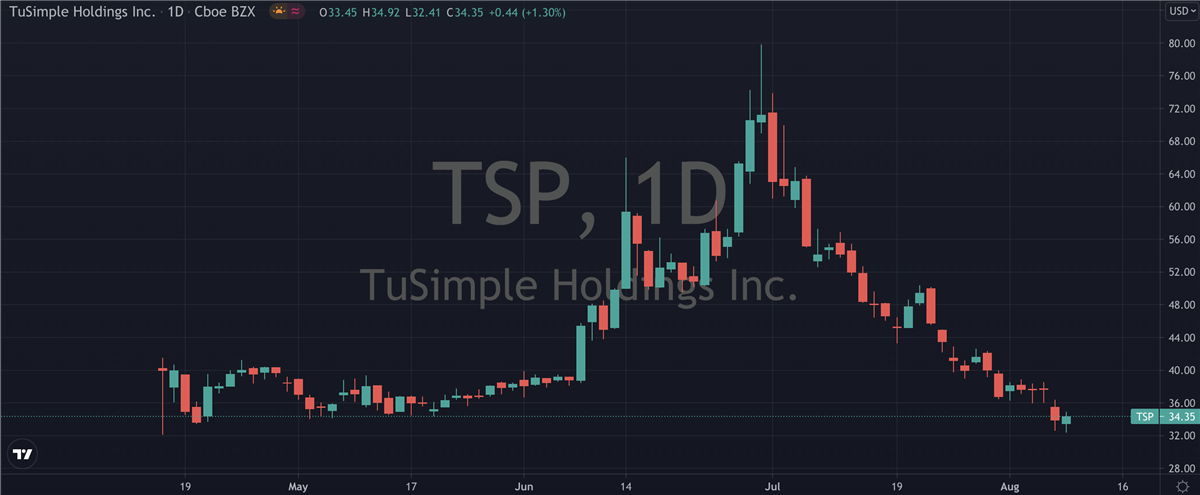Considering The Long Case For TuSimple (NASDAQ: TSP) For a company with simple in its name, there's been nothing easy about the first four months of public trading for investors of TuSimple (NASDAQ: TSP)...
By Sam Quirke
This story originally appeared on MarketBeat

For a company with simple in its name, there's been nothing easy about the first four months of public trading for investors of TuSimple (NASDAQ: TSP). As is the case with most freshly floated companies, shares of the Californian headquartered autonomous truck startup have had a rollercoaster couple of months since their IPO back in April. They started off trading fairly mildly all things considered, with a couple of 20% moves up and down before the stock started to consolidate and its daily trading range tightened up into May. But then came June, and within three weeks it had popped more than 100% in an eye-watering rally that surely caused more than a few champagne bottles to be popped.
But there the party suddenly stopped and the guests began to leave. Shares were down more than 50% from their peak by the end of July and they've continued to slide into August, coming within only a few cents of their all-time low (set on their first day of trading) yesterday. For management and investors, it could be said that now the real work has to start, or else the company risks becoming the latest poster child of those overhyped pre-revenue startups that had no business going public.
Grim Numbers
The company's Q2 earnings report, released towards the end of last week, would have made it clear to Main Street and Wall Street alike just how much work is required to justify their present valuation of $7 billion. Topline revenue came in at $260,000, which confirmed a drop of more than 80% compared to the same time period last year. It was also the guts of $800,000 less than what analysts were expecting, a miss that was compounded by similar softness in the bottom line EPS which was unsurprisingly deep in the red.
Cheng Lu, President, and CEO, chose to focus on the company's longer-term trajectory in the press release, saying that "TuSimple showed strong progress in Q2 2021 by focusing on key initiatives that support our long-term plans to launch the first autonomous freight network that enables low-cost, safe and reliable freight capacity. We deployed capital to accelerate the hiring of top-tier talent to propel development of our L4 autonomous driving system, the production partnership with Navistar, and the rapid expansion of our Autonomous Freight Network."
Long Term Potential
As an investor, if you're confident in the inevitability of autonomous vehicles, and trucks in particular, then a quarterly earnings report like this shouldn't really shake you. But all the same, it doesn't make for pretty reading, especially considering the level of hype that sent shares soaring back in June. Until shares start trending back up, bulls will have to rely on their long term conviction as well as positive sentiment from the likes of Morgan Stanley, Citi, and Oppenheimer who have all come out with either Outperform or Buy ratings on the stock since it went public.
The latter gave TuSimple shares a price target of $55, which from current levels suggests there's some pretty appetizing upside in the region of 60% to be had. Analyst Colin Rusch said at the time that "while still a development stage company, we view TuSimple as the global leader in autonomous trucking leveraging integrated hardware, motion planning and control algorithms, and infrastructure to address key pain points within the transportation and logistics (T&L) sector."
Needham analyst Rajvindra Gill echoed these comments over the summer when writing that "TuSimple is a first-mover in bringing autonomous vehicle capabilities to the trucking industry. This gives it a competitive advantage as it takes a significant amount of time to develop automotive-grade hardware, software and a network that supports the autonomous vehicles."
Considering the stock's trading along a decent support line while its relative strength index is at 30, suggesting it's extremely oversold, there's a fair argument to be had for initiating a speculative position at current levels. If the bears can't take it below $30, you'd expect the momentum to swing and it's likely this possibility that has Cathie Woods hoovering up shares at current prices for her innovation and robotics ETFs. 








